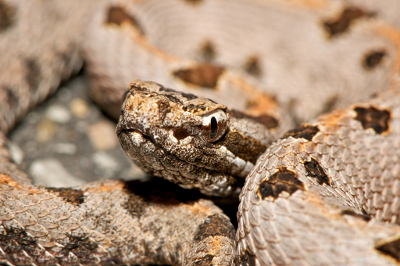Western Pygmy Rattlesnake
Category: Snakes

Facts about Western pygmy rattlesnake. "Scientific name for western pygmy rattlesnake is Sistrurus miliarius streckeri". The Western pygmy rattlesnake also known as the Strecker’s pigmy rattlesnake belongs to the genus Viperidae which includes the pit vipers and vipers in the order Squamata. The snake species is a subspecies of the venomous pit viper which is located in south-central parts of the United States extending to the far parts of southern Missouri along the Arkansas border and in the eastern Missouri, St. Francois and Ozarks Mountains.
The Western Pygmy Rattlesnake species likes to inhabit the south-facing, partially wooded and rocky hillsides which lie near glades, along the margins of forests, woods near rock ledges and meadows. The Western pygmy rattlesnake often basks on the rocks which are located in the open area, along roadsides near forests brush piles, or glades usually in early summer periods and in late springs. However, the Western pygmy rattlesnake also tends to be nocturnal and can be observed to shelter under rocks in autumn, spring and early summer, retreating into abandoned tiny mammals logs and burrows and crossing roads only during the night. This usually happens in the months of July and August.
The Western pygmy rattlesnake is a small, brightly colored rattlesnake which has a tiny rattle and a slender tail. The snake species is a medium to small sized snake which can grow to lengths of approximately fifteen to twenty inches (). The Western pygmy rattlesnake has a light brownish gray coloration with a row of small, dark brown spots one each side of the snake and similar spots on the back. Various species of the snake also tends to display a rust-colored stripe down the back of the body. Its belly is usually dusky cream or gray in color with many irregularly spaced bars. The Western pygmy rattlesnake’s head has a clear black stripe which can be observed to extend from the eye towards the corner of the snake’s mouth. The sensory pit is located between each eye and the nostril.
The disposition of the Western pygmy rattlesnake is observed to vary from one species to another. Some of the specie’s variety can vigorously defend themselves through sounding their rattles, coiling, jerking the head, and striking upon movement. However, a few of the specie’s variety remains motionless and can try to escape only upon being touched by a snake hook or a stick. Usually the Western pygmy rattlesnake produces a faint buzz can be heard a yard away and often resembles the sound of a grasshopper.
The Western pygmy rattlesnake can feed on a variety of other snake species, lizards, mice and rarely small insects and frogs. Having similar resemblance to other rattlesnakes, the western pygmy rattlesnake possesses hollow fangs which it uses to inject venom into the body of its prey. In addition, it also has heat-sensitive pits between the nostrils and the eyes allowing the snake species to be able to detect and accurately strike its prey including the warm- blooded rodents despite the total darkness conditions.
The Western pygmy rattlesnake species is observed to be secretive which allows them to remain uncommon to humans, with only a few numbers of human encounters. Although the Western pygmy rattlesnake is not fatal it is important to note that it requires not to be disturbed.

 Back To Category Snakes
Back To Category Snakes